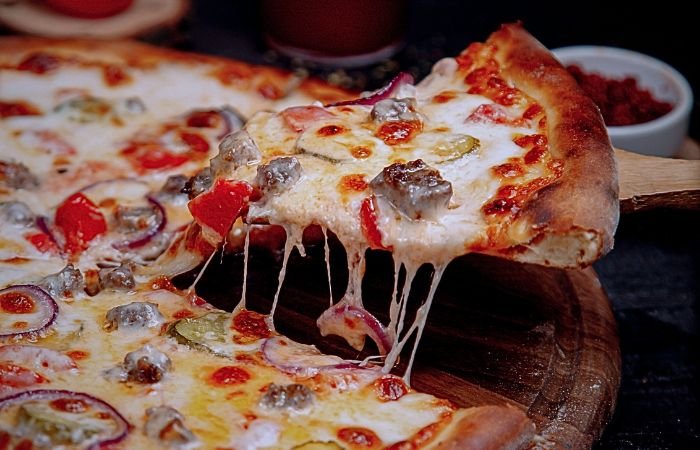A popular food all around the world, pizza is both an art and a science. This page offers the steps needed to become an expert pizza maker while focusing on the many flavors and varieties of pizza. While the science of making pizza includes knowing the chemical and physical processes that take place during preparation, the art of making pizza includes using creativity to prepare each component, leading to consistency and perfection in the final product. In order to truly master the art and science of baking pizza, correct measurements, timing, and temperature control are important.
Pizza, this word is enough to make your mouth water. It is the comfort dish that is universally adored by people of all ages. However, what makes pizza unique? Is it the chewy yet crispy crust, the melty, gooey cheese, or the rich, spicy sauce? Perhaps it’s the limitless selection of toppings that calm every craving. We all have a particular place in our hearts for pizza, whatever it is.
The History of Pizza:
The history of pizza is great, spanning across time and regions but closely linked to Italy, specifically Naples, its roots and development encompass a blend of cultures and culinary heritages.
Ancient Origins:
Flatbreads topped with various ingredients track back to Greeks, Egyptians, and Roman’s civilizations, all had their versions of flatbreads with a number of different topping items like olive oil, herbs, cheese or honey.
Emergence of Modern Pizza in Naples:
The pizza we are seeing today started to take form in Naples. At that period of time, Naples was a bustling port city with a diverse population, including many laborers in need of affordable and convenient food. Street vendors started selling flatbreads with diverse toppings, including tomatoes, which had been introduced to Europe from the Americas.
Pizza in the United States:
Immigrants took pizza to the United States, the first pizzeria opened in New York City where it became popular.
Ingredients You Must Have for Real Pizza:
Making an authentic pizza requires carefully choosing the proper ingredients, each serving an important function in attaining the perfect taste, consistency, and overall excellence. Here is a detailed look at the essential components required for crafting an authentic pizza:
1. Flour:
High-protein, finely ground options like Type 00 flour produce a pliable dough, resulting in a chewy yet tender crust.
Bread flour with slightly higher protein content can produce a similar effect.
2. Water:
Filtered or spring water is preferred to avoid unwanted flavors from tap water. The water should be at room temperature or slightly warm to activate the yeast effectively.
3. Yeast:
Active dry yeast, instant yeast, or fresh yeast with a shorter shelf life.
Essential for fermentation, aiding the dough to rise and develop flavor.
4. Salt:
Fine sea salt or kosher salt.
Enhances flavor and strengthens the dough by tightening the gluten structure.
5. Olive Oil:
Contributes to creating a crispy crust.
6. Tomatoes:
Tomatoes, renowned for their sweet, rich flavor.
Whole peeled tomatoes are recommended for ease of crushing or blending.
7. Cheese:
Fresh mozzarella for its creamy texture.
Other cheeses like Parmesan can be used.
8. Fresh Basil:
Fresh basil leaves.
Provides a fragrant, sweet, and slightly peppery flavor.
9. Additional Toppings:
Ingredients: Sausage, mushrooms, bell peppers, onions, olives, and pineapple.
Fresh, high-quality ingredients bring superior flavor and texture.
10. Seasonings:
Dried oregano, red pepper flakes, and black pepper.
Enhance the flavor.
Combining these carefully chosen ingredients lays the groundwork for an authentic pizza that brings tradition and artistry of this beloved dish. The quality and balance of these ingredients are important in achieving the genuine flavor.
Methods to Make the Ideal Baked Goods:
Hand Stretching the Dough: Use your hands to gently stretch the dough, instead of rolling the pin.
Oven Temperature: Pizzas should be baked in an oven at specifically mentioned temperature. For those who made it at home for Pizza Edition, temperatures can go even higher, closely similar to the conditions of traditional wood-fired ovens.
It’s important that the temperature be high. The optimal oven temperature for baking pizzas is between 450 and 500°F (232 and 260°C). Temperatures can be raised even further for homeowners who own a Pizza Edition oven or a pizza stone, simulating the characteristics of conventional wood-fired ovens.
Baking Time: Pizzas typically require only a few minutes to bake.
Variations Across the Globe:
While Italy remains the home of pizza, various forms have developed worldwide:
New York Style
Chicago Deep Dish
Neapolitan
Roman Pizza
Sicilian Pizza
Japanese Pizza
Brazilian Pizza
Healthier Pizza Options:
Health-conscious diners can also enjoy pizza with some changes:
Whole Wheat Dough
Low-Fat Cheese
Vegetable Toppings
Conclusion:
It’s a mix of tradition, science and innovation. The important elements of pizza making you can recreate this beloved dish with authenticity and passion.
The Pizza Edition is a popular option for a fast supper or a social gathering due to its adaptability and global appeal. Whether you like your pizza rich and layered with toppings or simple, utilizing good ingredients, learning the craft, and experimenting with flavors are the secrets to making it taste great. Accept the art of creating pizza and relish the countless variations of this popular meal.
With these suggestions and concepts, you’re ready to start making your own pizza that will satisfy and delight you. Never forget that practice, passion, and patience make the best pizza.
